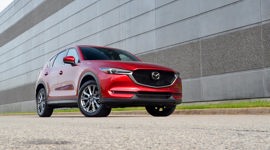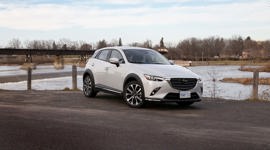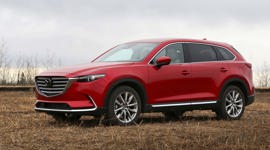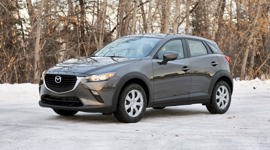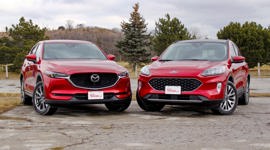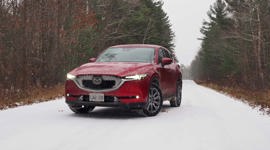 AutoTrader SCORE
AutoTrader SCORE
-
STYLING9/10
-
Safety9/10
-
PRACTICALITY7/10
-
USER-FRIENDLINESS7/10
-
FEATURES9/10
-
POWER8/10
-
COMFORT6/10
-
DRIVING FEEL9/10
-
FUEL ECONOMY8/10
-
VALUE8/10
Update (July 17, 2020): Correction: Navigation is standard on the GT and Signature trims; a previous version of this story stated that navigation was optional on all trims.
Needing three rows of seats used to put shoppers almost exclusively in minivan territory, but that’s no longer the case. Most automakers now offer that kind of capacity in their SUVs, with varying degrees of utility and comfort. One that mostly gets it right is Mazda’s CX-9.
For 2020, the CX-9 improves its ride quality with upgraded drivetrain dynamics – more on that later, of course – and adds some new features across its trim levels of GS, GS-L, GT, and my top-line Signature tester.
Pricing starts at $39,900 and rises to $51,500 for my ride. My tester was further optioned with an eye-catching coat of red for $450, bringing it to $51,950 before freight and taxes.
Styling: 9/10
Mazda’s designers have the eye, and the CX-9 is proof of that. Nothing really stands out on its own, but every element works to form a well-proportioned sport-ute. The grille’s just right, it blends back into the headlamps, and the taillights are tied together with just enough chrome. Many automakers are opting for sharp edges, but the CX-9 shows that smooth can be stylish.
All trim levels include auto-levelling LED headlamps, noise-insulating windshield, and rear privacy glass, while higher levels add a power liftgate and 20-inch wheels – which look good, but always remember that the bigger the wheel, the more you’ll pay for winter tires.
Safety: 9/10
The CX-9 gets the top five-star rating from the National Highway Traffic Safety Administration (NHTSA), and a Top Safety Pick+ from the Insurance Institute for Highway Safety (IIHS). What impresses me is that almost all of the CX-9’s high-tech safety assist features are standard on all trim levels, whereas some automakers make you move up before you start getting the goods.
So even the starter GS trim includes adaptive cruise control with stop-and-go function, emergency front braking with pedestrian detection, blind-spot monitoring, rear cross-traffic alert, lane-keeping assist, automatic high-beams, and active front head restraints, along with the rear-view camera that’s mandatory on all new vehicles. The GT and Signature add a 360-degree camera, head-up display, front and rear parking sensors, and steering-responsive headlights.
Practicality: 7.5/10
The CX-9 has much of the inherent practicality of a sport-utility vehicle, including very wide-opening rear doors for easy entry and exit (but be careful you don’t open them into the vehicle alongside you), and a hands-free liftgate that worked without fail, which isn’t always true of these systems.
The second and third rows fold flat, and it’s relatively easy to do that. But cargo space isn’t as large as in some competitors, and if you’ve got the third-row seats up, there’s not a lot of space back there. If you have a full house in the seats, don’t expect to bring much luggage or sports gear along with them.
User Friendliness: 7/10
The CX-9’s a bit of a mixed bag when it comes to making things happen. There are buttons and dials for several functions, including the climate controls and stereo volume, and they’re easy to use. But the touchscreen only functions by touch when the vehicle is stopped; otherwise, you use a console-mounted joystick to page between functions, and then select menu items. It’s relatively easy compared to some of the annoyingly complex systems out there, but I still find it simpler to tap an icon on the screen, and the distraction seems to be about the same for either method.
The head-up display settings are buried in the screen functions, a pain when different-sized drivers have to adjust its height; every brand should copy GM’s simple and superior toggle buttons for height control. My final quibble is with Mazda’s key fob, which is large but with tiny buttons on the side. Why, when there’s so much flat space on top for larger ones? When you’re walking alone to your vehicle at night, you want to easily find your lock and panic buttons.
Features: 9/10
In addition to the aforementioned high-tech safety items, the CX-9 comes with a decent list of features from the start. All include three-zone automatic climate control, three-level heated front seats, eight-way power driver’s seat, and Apple CarPlay and Android Auto, among other items. Moving up the scale adds such items as a new-for-2020 nine-inch touchscreen (the base is seven inches), leather upholstery, sunroof, ten-way driver’s seat, heated second-row seats, heated steering wheel, ventilated front seats, premium stereo, and second-row captain’s chairs. At the Signature trim, you get an auto-dimming rear-view mirror, Nappa leather, wood trim, and new for 2020, a “premium” centre console between the second-row seats.
Power: 8/10
The CX-9 is powered by a turbocharged 2.5L four-cylinder engine, which makes 227 hp and 310 lb-ft of torque on regular-grade fuel. If you want to go for premium 93-octane juice, Mazda says you’ll get 250 hp and 320 lb-ft. Power goes through a six-speed automatic transmission, and while buyers south of the border can opt for a front-wheel-drive version, all CX-9 models in Canada use all-wheel drive.
This is a sweet-and-spiffy little engine, with acceleration that’s stronger than the power numbers would suggest, thanks to that maximum torque coming in at a fairly low 2,000 rpm. A six-speed transmission might seem outdated when eight- and nine-speeds get all the press, but it’s an excellent fit to this engine, switching gears smoothly and without any fuss.
Comfort: 6/10
My Signature’s white leather seats looked good, but beauty is only skin deep. Despite looking comfortable, they were less so in person. They didn’t have the support I needed, and halfway into an hour-long drive, I was beginning to cramp up. The leather is slippery, and even though the seats are bolstered, I slid sideways in them around corners. Seat comfort can be an individual thing, but my better half had the same complaints. And the second-row seats weren’t any better.
But surprisingly for a vehicle this size, it was relatively easy for me to get past the middle chairs and into the third row. As with virtually all of these sport-utes, that third row is mostly for children, or for smaller adults on short trips, with hard-and-flat cushions and a high floor. But there is a lot of space under the second row for slipping one’s feet for a little extra room.
Driving Feel: 9/10
Mazda usually engineers a hefty glug of driving pleasure into its vehicles, and despite its family-hauler function, the CX-9 is a great vehicle to pilot. Steering response is quick and accurate, there’s very little body roll around corners, the ride is smooth and well-damped, and the cabin is quiet. About the only improvement I’d make is to have the brakes bite just a bit higher in the pedal travel.
Way upstream I mentioned the improved driving dynamics. Mazda dubs it G-Vectoring Control (GVC), and it’s a sophisticated system that momentarily reduces engine power on a turn, shifting the car’s weight to the front tires to improve its handling around the curve, and reduces jostling to your passengers. It’s been upgraded to GVC-Plus, which applies very light brake pressure as needed to smooth out lane changes or on slippery roads. The latter, brake-based torque-vectoring, is common in the industry these days, but it’s the combination of the two that makes Mazda’s system unique. It’s all so subtle that you won’t realize anything’s happening – you’ll just appreciate the smooth ride.
Fuel Economy: 8/10
The CX-9 is officially rated at 11.6 L/100 km in the city, 9.1 on the highway, and 10.5 L/100 km in combined driving. In my week with it, I averaged 11.4 L/100 km. Those published figures put it within a litre or less of three-row competitors such as the Ford Explorer, Hyundai Palisade, Kia Telluride, Subaru Ascent, and the non-hybrid version of the Toyota Highlander.
Value: 8/10
The CX-9 runs from $39,900 to $51,500. The GS, GS-L, and GT come with seven-passenger seating, but in the last two you can opt for six-passenger by adding second-row captain’s chairs for $300; they’re standard on the Signature. The only other options are three special paint colours, ranging from an extra $200 to $450.
Against some of its three-row all-wheel drive competitors, the CX-9 holds its own for price. The Ascent starts at $36,695 and tops out at $50,995; the Palisade starts lower but ends higher; and the Kia Telluride, Ford Explorer, and Toyota Highlander are all pricier.
The Verdict
I’ve always said that if you consistently fill all six or seven seats in your vehicle, you should get a minivan; they’re simply all-around better for comfort and cargo. But if driving a full house is only occasional and you want a sport-ute, then the CX-9 deserves some cross-shopping. It’s good-looking and it’s great to drive, and there’s nothing that says you can’t haul people and have fun behind the wheel at the same time.
| Engine Displacement | 2.5L |
|---|---|
| Engine Cylinders | I4 |
| Peak Horsepower | 227 hp @ 5,000 rpm (87 octane fuel); 250 hp @ 5,000 rpm (93 octane fuel) |
| Peak Torque | 310 lb-ft @ 2,000 rpm (87 octane fuel); 320 lb-ft @ 2,000 rpm (93 octane fuel) |
| Fuel Economy | 11.6 / 9.1 / 10.5 L/100 km cty/hwy/cmb |
| Cargo Space | 407 / 1,082 / 2,017 L behind 3rd/2nd/1st row |
| Model Tested | 2020 Mazda CX-9 Signature |
| Base Price | $51,500 |
| A/C Tax | $100 |
| Destination Fee | $1,950 |
| Price as Tested | $54,000 |
|
Optional Equipment
$450 – Soul Red Crystal Metallic paint, $450
|
|















































